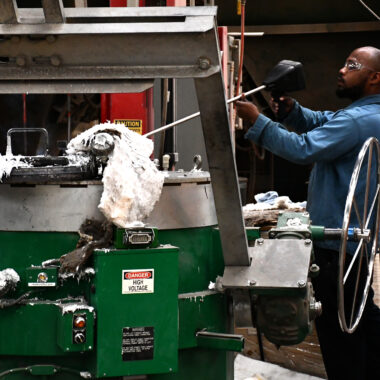Aluminum Casting Illinois: Where Technology Fulfills Practice
Wiki Article
Understanding the Craft: Specialist Tips for Flawless Light Weight Aluminum Spreading Outcomes
In the realm of light weight aluminum precision, competence and casting are critical to achieve impeccable results. Understanding the craft calls for a thorough understanding of the devices and devices at one's disposal, an eager eye for preparing the aluminum alloy to specific specifications, and a nimble hand in utilizing ideal casting techniques. Nonetheless, truth mark of a skilled expert depend on their capability to achieve flawlessly smooth surface area coatings that raise the high quality of the end product. Quality control and troubleshooting are important elements that can make or break a casting job, making sure that every action is implemented with miraculous treatment and attention to detail.Vital Tools and Tools
Light weight aluminum spreading calls for specific devices and devices to make certain precision and efficiency in the process. The crucible, usually made of graphite or ceramic products, holds up against high temperature levels required to thaw light weight aluminum. The mold and mildew, usually made of steel or sand, forms the liquified aluminum into the wanted kind.Additionally, tools like aprons, tongs, and handwear covers are necessary to guarantee the safety of operators working with molten aluminum. Spending in top quality tools and tools not only enhances the precision of aluminum spreading but additionally contributes to an extra safe and efficient manufacturing process.
Preparing the Aluminum Alloy
To guarantee the success of the light weight aluminum spreading process, thorough preparation of the alloy is paramount. The first action in preparing the aluminum alloy is to meticulously choose the appropriate type of light weight aluminum based on the features needed for the last product.After cleansing, the following crucial step is to warm the aluminum to the ideal temperature level for spreading. This process, recognized as alloy melting, guarantees that the aluminum remains in its molten kind and ready for spreading (aluminum casting illinois). Furthermore, controlling the temperature level throughout melting is essential to avoid getting too hot or underheating, which can lead to issues in the end product. On the whole, meticulous preparation of the aluminum alloy sets the foundation for a successful spreading procedure and premium outcome.
Optimum Casting Methods
Applying exact spreading techniques is crucial for accomplishing premium outcomes in light weight aluminum casting procedures. The light weight aluminum should be heated up to the optimum temperature to lower problems like contraction and porosity in the final cast.Furthermore, preserving regular pouring rate and stress is essential to achieving harmony in the cast item. Steady and slow-moving pouring helps stop turbulence and air entrapment, which can bring about flaws. Another vital aspect is the usage of degassing agents to eliminate impurities and gases from the molten light weight aluminum, leading to a cleaner last item.

Getting Smooth Surface Area Ends Up
For manufacturers looking for to improve the aesthetic allure and top quality of their light weight aluminum spreadings, achieving smooth surface coatings is an important facet adhering to precise casting methods and proper cooling procedures. One trick method to achieve smooth surface area finishes is by making use of high-grade molds that are properly prepared and kept. The mold surface area must be thoroughly cleansed and covered with release agents to stop flaws moving onto the cast light weight aluminum during the cooling process.Moreover, regulating the cooling rate of the light weight click here for info aluminum spreading is vital for attaining a smooth surface coating. Quick cooling can cause thermal gradients that result in appear flaws, while slow-moving air conditioning might create microstructural issues - aluminum casting illinois. By carrying out controlled cooling processes, such as using air or water quenching techniques, suppliers can ensure that the light weight aluminum strengthens evenly, decreasing the chance of surface flaws
Along with more information mold and mildew high quality and cooling treatments, post-casting therapies like shot blasting or chemical etching can better refine the surface area coating of light weight aluminum spreadings. These strategies aid smoothen out any kind of continuing to be roughness or pollutants, leading to a flawless look that meets the finest standards.
Quality Assurance and Troubleshooting

In the realm of troubleshooting, it is vital to have a thorough understanding of usual issues that can take place throughout aluminum casting, such as contraction, surface, or porosity irregularities. Continuous improvement via top quality control and fixing methods is fundamental to attaining perfect results in light weight aluminum spreading.
Final Thought
To conclude, understanding the craft of light weight aluminum spreading needs vital devices and devices, proper prep work of the aluminum alloy, ideal casting methods, achieving smooth surface area coatings, and carrying out quality control procedures. By complying with these professional pointers, perfect outcomes can be achieved in light weight aluminum spreading processes. Quality assurance and troubleshooting are essential aspects to think about to ensure constant and high-quality cause light weight aluminum casting jobs.The initial action in preparing the aluminum alloy is to internet meticulously select the proper kind of light weight aluminum based on the characteristics required for the last item.Implementing accurate spreading strategies is important for attaining premium outcomes in aluminum casting processes. By mastering these optimum casting methods, manufacturers can constantly produce perfect light weight aluminum spreadings.
For producers looking for to enhance the visual appeal and quality of their light weight aluminum spreadings, accomplishing smooth surface area finishes is an essential aspect following exact casting techniques and correct cooling treatments.In conclusion, understanding the craft of aluminum spreading requires necessary devices and equipment, proper preparation of the light weight aluminum alloy, optimal spreading techniques, accomplishing smooth surface area finishes, and carrying out quality control actions.
Report this wiki page